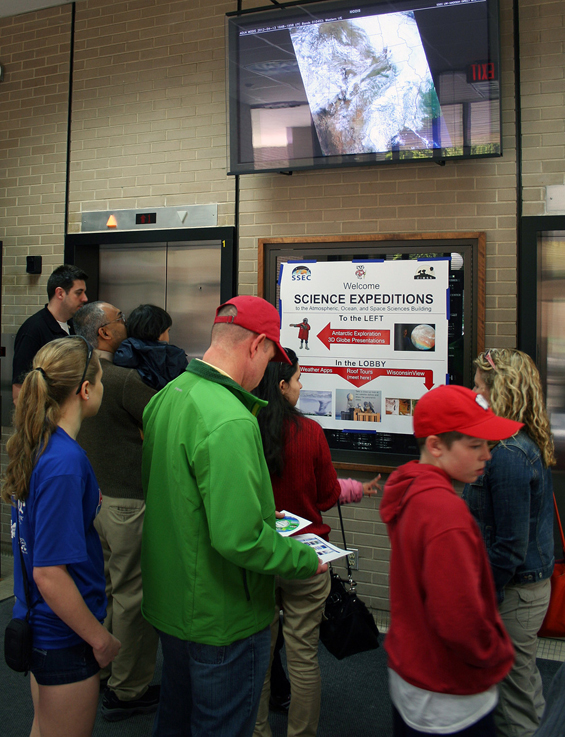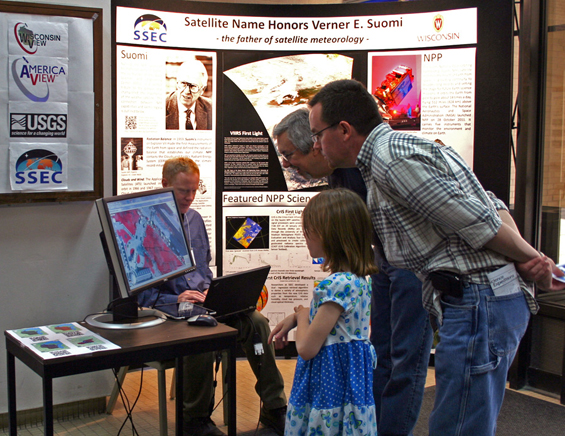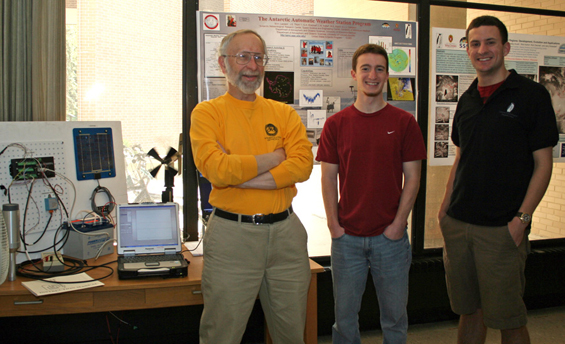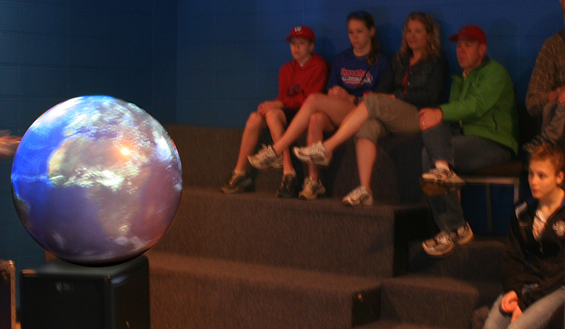Monthly News Summary – May 2012
- 10th Annual Science Expeditions Visits AOSS
- The Second Annual AOSS Community Poster Reception
- Chris Beley Wins the Qualcomm Wireless Innovation Prize
- UW-Madison’s Newest “Eyes in the Sky”
- Velden Receives Chancellor’s Award for Excellence in Research
10th Annual Science Expeditions Visits AOSS
Enthusiastic learners of all ages flooded the UW-Madison campus on Saturday, 14 May 2012, for the 10th Annual Science Expeditions event.
An estimated 250 explorers made their way to the AOSS Building where they were guided through several displays, demonstrations, and spectacular views of satellite dishes and the Madison campus from the roof.
On hand to give the explorers a good look at the work done in the AOSS Building were:
Sam Batzli presented the impressive images of WisconsinView.
Tom Whittaker introduced young explorers to his collection of weather applets.
George Weidner gave demonstrations of the Antarctic Automatic
Weather Station Program with David Mikolajczyk and Nick Weber.
As presented by Rick Kohrs and Patrick Rowley,
the 3D Science on a Sphere captivated crowds.
Margaret Mooney and Patrick Rowley (center), along with Mark Hobson, Britta Gjermo and Tom Whittaker, answered questions on the roof.
The Second Annual AOSS Community Poster Reception
Attention faculty, staff, and students affiliated with centers and departments in the Atmospheric, Oceanic and Space Sciences Building:
The Second Annual AOSS Community Poster Reception will be held Monday, 14 May 2012 in Varsity Hall at Union South from 3-6 pm. This *free* event showcases the innovative science, engineering, educational outreach, and other projects going on in the Atmospheric, Oceanic and Space Sciences Building today!
Please feel free to present a recent poster of your work (for example, from AGU, AMS or some other recent conference), or a poster from last year’s reception, or just come and check out all the great projects happening here! There will be free snacks and refreshments. We will also award cash prizes for the best graduate and undergraduate posters.
You do not need to bring a poster, but you do need to register to attend – registration is open until 10 May 2012. Please see the attached announcement and visit our website to register, submit a poster, or learn more:
We hope to see you all there!
Chris Beley Wins the Qualcomm Wireless Innovation Prize
Congratulations to Technical Computing’s own Chris Beley for winning the Qualcomm Wireless Innovation Prize! Beley’s Flextory, a flexible, web-based inventory system designed for multiple inventory scenarios took the top prize and a cash award.
The Qualcomm Wireless Innovation Prize, sponsored by the San Diego-based mobile technology company, rewards students who present creative wireless technology products and well-developed business plans. The competition was held Wednesday 18 April 2012 in the Wisconsin Institutes for Discovery.
UW-Madison’s Newest “Eyes in the Sky”
The Space Science and Engineering Center (SSEC), with its large array of satellite dishes atop its towering building, isn’t the only place on south campus with “eyes in the sky.” The climate research facility has a bird’s eye view of some of the University of Wisconsin-Madison’s newest residents: a nesting pair of red-tail hawks and their three tiny white chicks.
The hawks have nested on a protruding window ledge of nearby Weeks Hall, giving the researchers at SSEC an excellent opportunity to watch the young family grow and prosper. Taking a hint from their own satellite-based research, SSEC researchers have re-purposed a roof-top camera to provide a 24-7 video feed of the nest.
If not pulling “nest duty,” one or another of the proud parents can usually be seen either perched on one of the rooftop instruments of SSEC, or flying high in the sky, peering down in search of the chicks’ next meal.
Male and female red-tailed hawks are nearly identical in appearance, making differentiation from a distance almost impossible. They mate for life and often return to the same nest for several years. They lay up to three eggs in the early spring. After four to five weeks, the eggs hatch and snow white chicks, known as eyasses, emerge, mouths open and hungry. After another six to seven weeks the young raptors will begin to leave the nest for short flights, honing their hunting skills. Ten weeks later they strike out on their own.
Two years ago, hawks built a nest on the Weeks Hall window. Last year they returned and SSEC placed a small video camera to watch them hatch and fledge their young. This year a higher resolution camera provides an even better view.
“Our streaming video web page has had over 50,000 hits and over 30,000 unique visitors since the camera went online in late March,” says John Lalande of SSEC’s Technical Computing Department. “We have had visitors from at least 50 countries so far. Traffic has definitely spiked over the last few days. At the beginning of the week, we might have had around 100 simultaneous viewers. By Thursday, we were over 500. Similarly, hits per day on the web site went from a few hundred a day over the first few weeks to a few thousand per day this week.”
Oblivious to all this attention, the hawks feed their young and prepare them for their own time in the sky.
Satellites orbiting overhead in space, raptors soaring over South Campus, or visitors to the hawk’s streaming web page, many eyes are gazing down on the UW campus.
Velden Receives Chancellor’s Award for Excellence in Research
Chris Velden, senior researcher at the Space Science and Engineering Center, is the recipient of the University of Wisconsin Chancellor’s Award for Excellence in Research. This award, given to an independent university researcher, recognizes a lifetime achievement for significantly impacting their discipline. Velden’s nomination package included strong recommendations of support from international and national institutions, including NOAA’s National Hurricane Center. The award was presented on 09 May 2012 at a special Chancellor’s honors ceremony.
Christopher Velden, senior scientist in the Space Science and Engineering Center at the University of Wisconsin-Madison, is pictured with the rooftop array of satellite dishes atop the Atmospheric, Oceanic and Space Science Building.
Photo credit: Bryce Richter
“Many scientists do well in a few areas, while few excel across the board,” says Jeffrey D. Hawkins of the Naval Research Laboratory in Monterey, Calif. “(Velden) has participated in more than 10 field programs around the globe, illustrating his thirst to truly understand what the atmosphere is trying to tell us via multiple airborne/satellite campaigns.”











